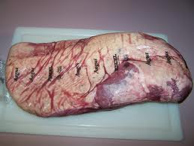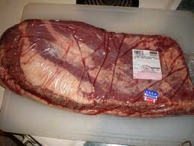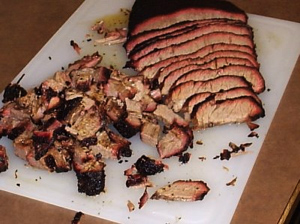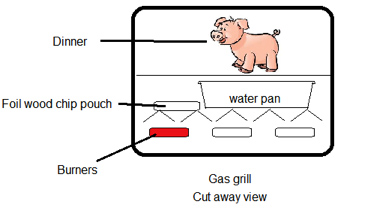Brisket – One Tough Hombre
Back in the old days, they used to boil it into submission. It wasn’t fit for the grill. People would grind them up for burger or sell it for stew meat. In Ireland as far back as the 1600’s, they would “corn” it (let it cure in salt for a few days) before they boiled it. More recently, a German butcher in Texas tossed a brisket into a smoker that he used for smoking sausages and Texas BBQ Brisket was born.
When selecting a brisket for bbq, you should try to find what’s called a “packer cut”. This will have two large muscles separated by a layer of fat and comes vacuum sealed in cryovac.

Here’s the top of a brisket in cryovac. The “point” is on the right side, the “flat” is under the fat on the left side.

This is the bottom of the brisket. The “flat” is now on the right side of the pic.
Here in Kansas City, you can get them at Sam’s Club or Costco. DO NOT BUY A TRIMMED BRISKET. You will need the fat left on to protect the meat. Don’t worry about your diet; you’ll trim off the fat after the brisket is cooked. Beef is graded by quality. Prime is best, choice is next, then comes select. Most of the beef you buy in grocery stores is select beef. Most of the prime beef is sold to restaurants or shipped to Japan. They like beef a lot over there. They’ve been eating nothing but fish and pickled vegetables for thousands of years. The Sam’s and Costco sell choice beef here. Try to find choice if you can. If you can’t, select will do. Look for a brisket with hard, white fat and as much marbling as you can get. Cooking is pretty simple. Trim the fat side down leaving about ½ inch of fat on top. Rub some oil or a thin layer of mustard all over, top, bottom, and all sides. Sprinkle heavily with bbq rub. You can leave it marinate in this rub overnight for more flavor if you like. Get your pit going at 250 degrees with a few wood chunks. Put the brisket on fat side down. Leave the exhaust open; adjust your temp where the air comes in. After four hours into the cook; spray with apple juice every half hour. The hardest part of cooking a brisket is keeping your pit temp up for the length of the cook. Depending on the size of the brisket, it can take anywhere between 10 and 16 hours. You can add a few wood chunks every hour or so during the cook for smoke flavor.
When is it done?
Take your meat thermometer and check the internal meat temperature in the center of the flat after 8 hours into the cook. It will read anywhere from 150 to 170. The brisket will be done at around 200 degrees internal. You will just check it every 30 minutes or so towards the end of the cook. WARNING: If you check the temp during the cook and come back two or three hours later and it still reads the same temperature, do not panic. After you place your brisket on the pit, it will increase from room temperature to around 160 degrees (plus or minus 10 degrees or so) in three to four hours. Then the temperature will get “stuck” in what we call a plateau. This is normal. Nothing is wrong with your pit. Just keep it at 250 degrees and after another four or five hours, the temperature will start to climb again. There is no “perfect” done temperature. I always go by feel. At 190 degrees, take your meat thermometer or a metal skewer or something similar, and insert it into the center of the brisket flat from the top. There will be some resistance going in and as you pull it out, the brisket will lift off the grill slightly. The longer you cook it, the easier it will slide in and out until at some point it will slide in easily and the brisket will not ”hold on” as you pull it out. Sounds a little complicated, but once you do it, it will be obvious. The “done” temperature will vary slightly, but it’s usually around 200 to 205 degrees. This will give you brisket that you can slice thick like we do in competitions. For slicing thin and piling high on a sandwich, I would take the brisket off a little early. Some restaurants will stop cooking at around 180 to 190 degrees. That way the meat won’t fall apart as they run it across a meat slicer. But they slice very thin so it is easy to chew.

Here’s the “point”, chopped into Burnt Ends on the left and the “flat” sliced up on the right.
Now that the brisket is off of the pit, let it rest for a half an hour, then turn it fat side up and trim the fat off. The flat and the point can be separated now. Just find the fat layer between the two and run a knife through it. Scrape all of the fat off of the separated flat and point. Slice the flat across the grain to make sandwiches.
Kansas City Burnt Ends
Put the point back on the pit (I like to put it in a hot spot if I have one) for another hour. Then cut the point into 1 inch cubes and eat them.
Or, you can cut up the point into 1 inch cubes, sauce up the cubes, then put them back on the pit in a pan and smoke them for a couple of hours.
Note: If you don’t want to run a pit for 10 to 16 hours, you can smoke the brisket for four or five hours, then finish it in an oven set at 210 degrees overnight.
This is for Jim over at UP.
How to turn your gas grill into a smoker.
Buy an aluminum foil roasting pan. Put it under the cooking grate of your grill.

Fill it halfway up with water. Soak some wood chips for an hour. Wrap up a handful of chips in aluminum foil and put it on the burner next to the pan. Poke a few holes in the foil pouch to let some smoke escape. Turn your gas (ugh) on as low as it will go. You might just use one burner. You’re looking for around 250 degrees. Put your meat on above the water pan. Replace the foil pouch with another when there is no more smoke coming out of it.
Remember … If you have any BBQ questions, you can email me at: dbrewer@buckeyemountain.com

